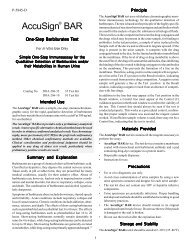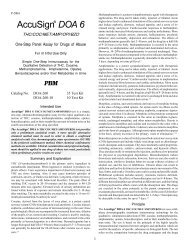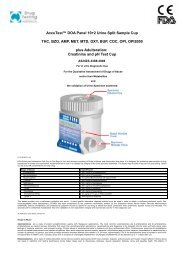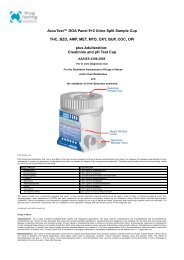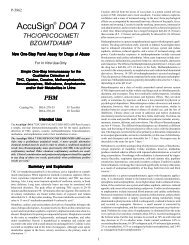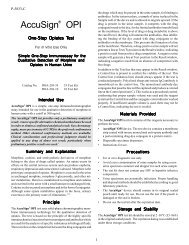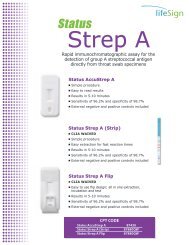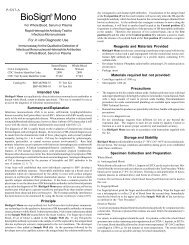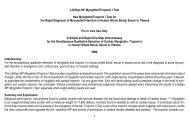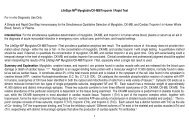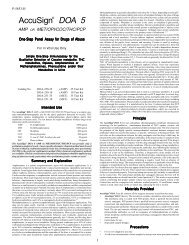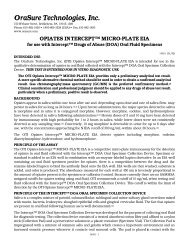AccuSign® DOA 4 - Drug Testing Australia
AccuSign® DOA 4 - Drug Testing Australia
AccuSign® DOA 4 - Drug Testing Australia
Create successful ePaper yourself
Turn your PDF publications into a flip-book with our unique Google optimized e-Paper software.
Add 3 drops<br />
(110 µL)<br />
Read in 5–10<br />
minutes<br />
®<br />
AccuSign<br />
<strong>DOA</strong> 4<br />
Date<br />
ID<br />
C<br />
THC<br />
OPI<br />
COC<br />
MET<br />
Sample<br />
3 drops<br />
No Line = +<br />
Line = –<br />
CONTROL (VALIDATION) LINE (C).<br />
The Control/Validation line indicates:<br />
1. If the proper amount of sample was used;<br />
2. If the sample wicked;<br />
3. If the procedure was followed properly.<br />
If no control line appears, the test is NOT VALID.<br />
Repeat the test using a new device, and follow the<br />
procedure carefully.<br />
C<br />
THC<br />
OPI<br />
COC<br />
MET<br />
(2) (3) (4) (5)<br />
OR<br />
C<br />
OR<br />
C<br />
OR<br />
THC<br />
OPI<br />
COC<br />
MET<br />
THC<br />
OPI<br />
COC<br />
MET<br />
C<br />
THC<br />
OPI<br />
COC<br />
MET<br />
Sample<br />
3 drops<br />
C<br />
THC<br />
OPI<br />
COC<br />
MET<br />
ID<br />
Date<br />
®<br />
AccuSign<br />
<strong>DOA</strong> 4<br />
(1)<br />
THC (–)<br />
OPI (–)<br />
COC (–)<br />
MET (+)<br />
THC (+)<br />
OPI (–)<br />
COC (+)<br />
MET (–)<br />
THC (–)<br />
OPI (+)<br />
COC (–)<br />
MET (–)<br />
INVALID<br />
No Line = +<br />
Line = –<br />
Negative (–) = Control line and Specific <strong>Drug</strong> line<br />
Positive (+) = Control line only; No Specific <strong>Drug</strong> line<br />
Precautions<br />
• For in vitro diagnostic use only.<br />
• Avoid cross contamination of urine samples by using a new<br />
urine specimen container and dropper for each urine sample.<br />
• This test kit does not contain any HIV or hepatitis infective components.<br />
• Urine specimens are potentially infectious. Proper handling and disposal<br />
methods should be followed, according to good laboratory practices.<br />
• The AccuSign ® device should remain in its original sealed pouch until<br />
ready for use.<br />
• Do not use the test kit after the expiration date.<br />
Storage and Stability<br />
The AccuSign ® <strong>DOA</strong> 4 test kit should be stored at 2–30 ° C (35–86 ° F) in the<br />
original sealed pouch. The expiration dating was established under these<br />
storage conditions.<br />
Specimen Collection and Preparation<br />
Approximately 110 µL of urine sample is required for each test. Fresh urine<br />
specimens do not require any special handling or pretreatment. Specimens<br />
should be collected in a clean glass or plastic container. If testing will not be<br />
performed immediately, specimens should be refrigerated (2–8 ° C) or frozen.<br />
Specimens should be brought to room temperature before testing.<br />
Specimens containing a large amount of particulate matter may give inconsistent<br />
test results. These specimens should be clarified by centrifuging or<br />
allowing to settle before testing.<br />
Test Procedure<br />
The test procedure consists of adding the urine sample to the Sample well of<br />
the device and watching for the appearance of colored lines in the result<br />
window.<br />
Test Protocol<br />
1. For each test, open one AccuSign ® <strong>DOA</strong> 4 pouch<br />
and label the AccuSign ® <strong>DOA</strong> 4 device with the<br />
patient ID.<br />
2. Holding the dropper vertically, dispense 3 full drops<br />
(110 µL) of the urine sample into the Sample well.<br />
3. Read the result after 5 minutes, but within 10 minutes.<br />
Interpretation of Results<br />
Negative: The appearance of a reddish-purple Control line (C) and a line<br />
for a specific drug indicates a negative test result; i.e., no drug above the cutoff<br />
level has been detected. The color intensities of the Control line and a specific<br />
drug line may not be equal. Any faint line at a specific drug name in the Result<br />
window, visible in 10 minutes, should be interpreted as negative. A negative<br />
test result does not indicate the absence of drug in the sample; it only indicates<br />
the sample does not contain drug above the cutoff level in qualitative terms.<br />
Positive: The appearance of a reddish-purple Control line and no distinct<br />
line at a specific drug name indicates the test result is positive for that drug (i.e.,<br />
the specimen contains the drug at a concentration above the cutoff level). A<br />
positive test result does not provide any indication of the level of intoxication<br />
or urinary concentration of the drug in the sample; it only indicates the sample<br />
contains drug above the cutoff level in qualitative terms.<br />
Invalid: A distinct Control line (C) should always appear. The test is invalid<br />
if no Control line forms at the C position. Such tests should be repeated with<br />
a new AccuSign ® <strong>DOA</strong> 4 test device.<br />
Examples of possible results are shown in the diagram above.<br />
(1) THC (–), Opiates (–), Cocaine (–), Methamphetamines (–): Five<br />
reddish-purple lines—one Control line at the C position and one each at<br />
the THC, OPI, COC, and MET positions.<br />
(2) THC (–), Opiates (–), Cocaine (–), Methamphetamines (+): Four<br />
reddish-purple lines—one Control line at the C position and one line each<br />
at the THC, OPI, and COC positions; no line at the MET position.<br />
(3) THC (+), Opiates (–), Cocaine (+), Methamphetamines (–): Three<br />
reddish-purple lines—one Control line at the C position, one line each at<br />
the OPI and MET positions; no lines at the THC and COC positions.<br />
(4) THC (–), Opiates (+), Cocaine (–), Methamphetamines (–): Four<br />
reddish-purple lines—one Control line at the C position and one line each<br />
at the THC, COC, and MET positions; no line at the OPI position.<br />
(5) Invalid: No line at the C position.<br />
There are other possible results, depending on the combinations of drugs<br />
present in the urine sample.<br />
Limitations<br />
• The test is designed for use with unadulterated urine only.<br />
• There is a possibility that factors such as technical or procedural errors,<br />
as well as other substances in the urine sample than those listed in Table<br />
4 below, may interfere with the test and cause erroneous results.<br />
• Adulterants, such as bleach and/or alum, in urine specimens may produce<br />
2



